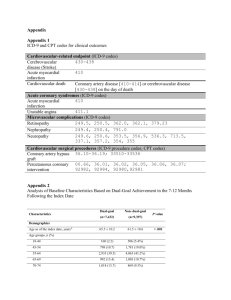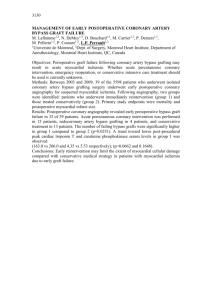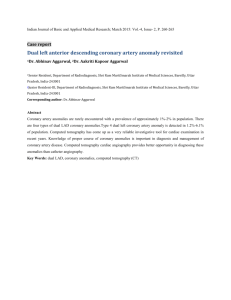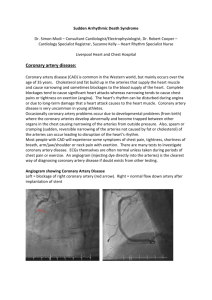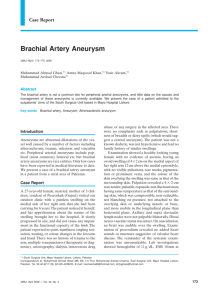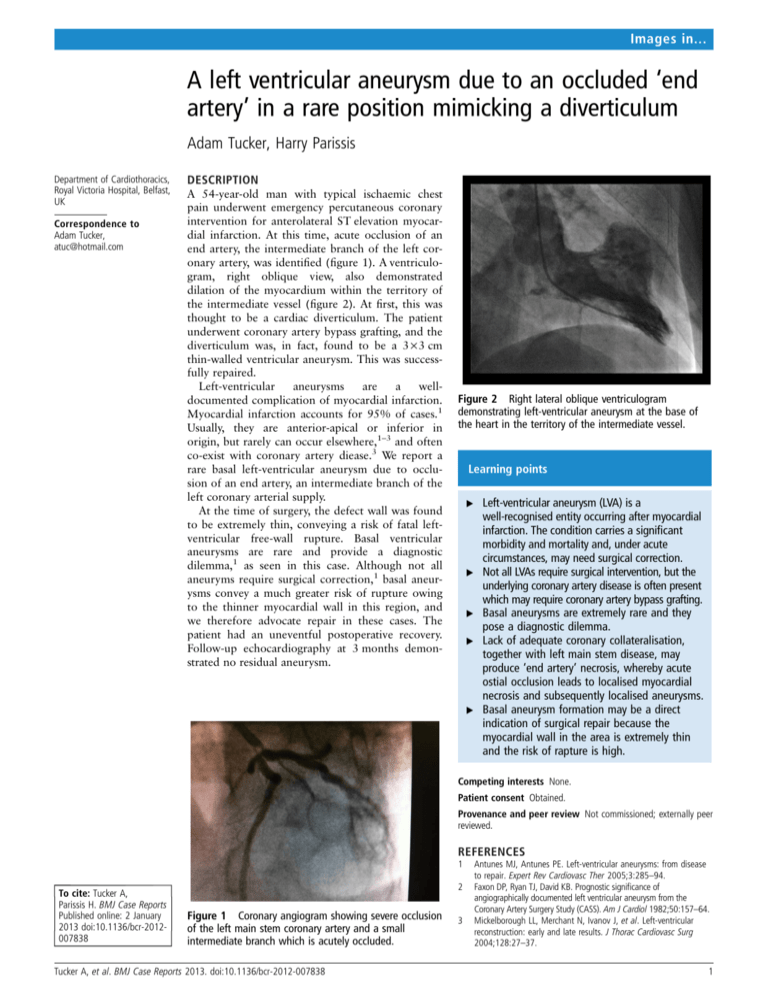
Images in...
A left ventricular aneurysm due to an occluded ‘end
artery’ in a rare position mimicking a diverticulum
Adam Tucker, Harry Parissis
Department of Cardiothoracics,
Royal Victoria Hospital, Belfast,
UK
Correspondence to
Adam Tucker,
atuc@hotmail.com
DESCRIPTION
A 54-year-old man with typical ischaemic chest
pain underwent emergency percutaneous coronary
intervention for anterolateral ST elevation myocardial infarction. At this time, acute occlusion of an
end artery, the intermediate branch of the left coronary artery, was identified (figure 1). A ventriculogram, right oblique view, also demonstrated
dilation of the myocardium within the territory of
the intermediate vessel (figure 2). At first, this was
thought to be a cardiac diverticulum. The patient
underwent coronary artery bypass grafting, and the
diverticulum was, in fact, found to be a 3×3 cm
thin-walled ventricular aneurysm. This was successfully repaired.
Left-ventricular
aneurysms
are
a
welldocumented complication of myocardial infarction.
Myocardial infarction accounts for 95% of cases.1
Usually, they are anterior-apical or inferior in
origin, but rarely can occur elsewhere,1–3 and often
co-exist with coronary artery diease.3 We report a
rare basal left-ventricular aneurysm due to occlusion of an end artery, an intermediate branch of the
left coronary arterial supply.
At the time of surgery, the defect wall was found
to be extremely thin, conveying a risk of fatal leftventricular free-wall rupture. Basal ventricular
aneurysms are rare and provide a diagnostic
dilemma,1 as seen in this case. Although not all
aneuryms require surgical correction,1 basal aneurysms convey a much greater risk of rupture owing
to the thinner myocardial wall in this region, and
we therefore advocate repair in these cases. The
patient had an uneventful postoperative recovery.
Follow-up echocardiography at 3 months demonstrated no residual aneurysm.
Figure 2 Right lateral oblique ventriculogram
demonstrating left-ventricular aneurysm at the base of
the heart in the territory of the intermediate vessel.
Learning points
▸ Left-ventricular aneurysm (LVA) is a
well-recognised entity occurring after myocardial
infarction. The condition carries a significant
morbidity and mortality and, under acute
circumstances, may need surgical correction.
▸ Not all LVAs require surgical intervention, but the
underlying coronary artery disease is often present
which may require coronary artery bypass grafting.
▸ Basal aneurysms are extremely rare and they
pose a diagnostic dilemma.
▸ Lack of adequate coronary collateralisation,
together with left main stem disease, may
produce ‘end artery’ necrosis, whereby acute
ostial occlusion leads to localised myocardial
necrosis and subsequently localised aneurysms.
▸ Basal aneurysm formation may be a direct
indication of surgical repair because the
myocardial wall in the area is extremely thin
and the risk of rapture is high.
Competing interests None.
Patient consent Obtained.
Provenance and peer review Not commissioned; externally peer
reviewed.
REFERENCES
1
To cite: Tucker A,
Parissis H. BMJ Case Reports
Published online: 2 January
2013 doi:10.1136/bcr-2012007838
2
Figure 1 Coronary angiogram showing severe occlusion
of the left main stem coronary artery and a small
intermediate branch which is acutely occluded.
Tucker A, et al. BMJ Case Reports 2013. doi:10.1136/bcr-2012-007838
3
Antunes MJ, Antunes PE. Left-ventricular aneurysms: from disease
to repair. Expert Rev Cardiovasc Ther 2005;3:285–94.
Faxon DP, Ryan TJ, David KB. Prognostic significance of
angiographically documented left ventricular aneurysm from the
Coronary Artery Surgery Study (CASS). Am J Cardiol 1982;50:157–64.
Mickelborough LL, Merchant N, Ivanov J, et al. Left-ventricular
reconstruction: early and late results. J Thorac Cardiovasc Surg
2004;128:27–37.
1
Images in...
Copyright 2013 BMJ Publishing Group. All rights reserved. For permission to reuse any of this content visit
http://group.bmj.com/group/rights-licensing/permissions.
BMJ Case Report Fellows may re-use this article for personal use and teaching without any further permission.
Become a Fellow of BMJ Case Reports today and you can:
▸ Submit as many cases as you like
▸ Enjoy fast sympathetic peer review and rapid publication of accepted articles
▸ Access all the published articles
▸ Re-use any of the published material for personal use and teaching without further permission
For information on Institutional Fellowships contact consortiasales@bmjgroup.com
Visit casereports.bmj.com for more articles like this and to become a Fellow
2
Tucker A, et al. BMJ Case Reports 2013. doi:10.1136/bcr-2012-007838



